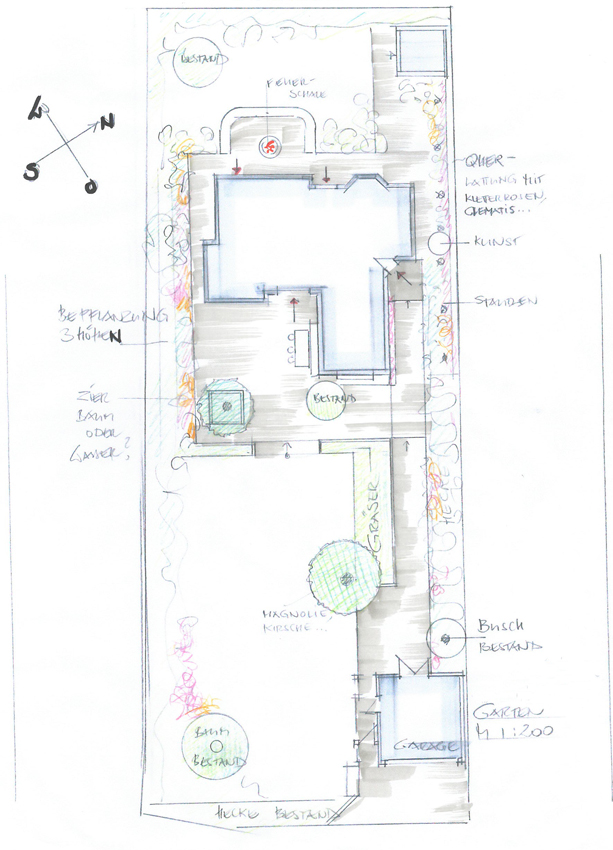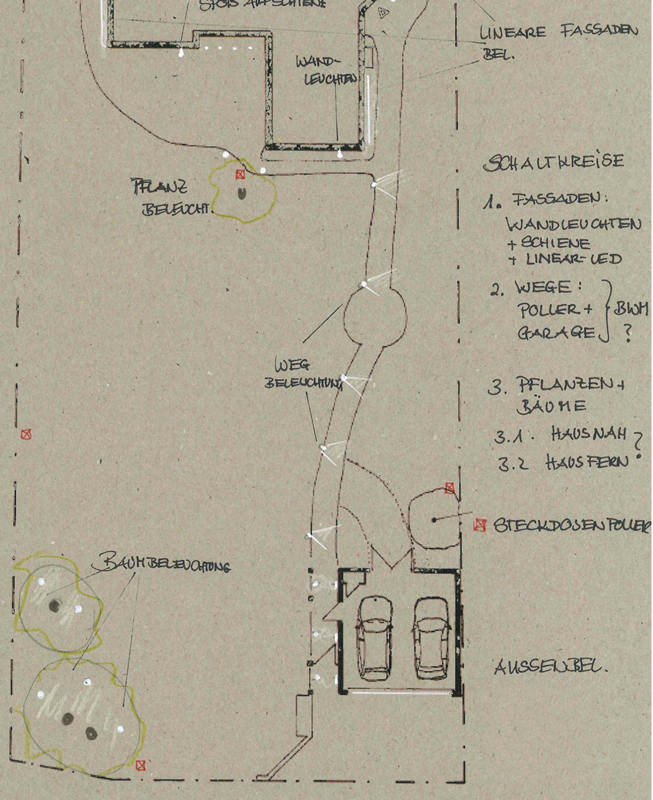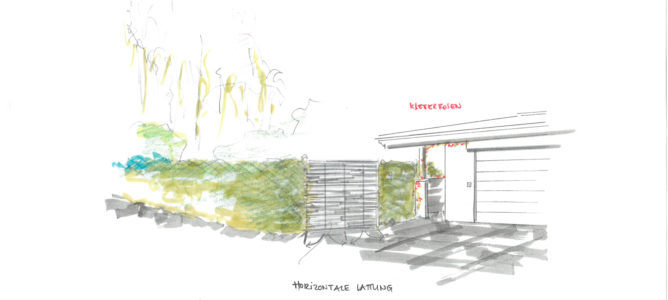It is especially during spring that many clients turn to me to ask about options for re-designing their yards and gardens. This article provides a few tips to help you find ideas and inspiration.
The days of grayness have now passed. Blossoms and sprouts are all around us, and we feel more motivated again to go spend time outdoors. As an interior designer, I often take on projects not only for indoor spaces, but for outdoor spaces as well.
You’d like to re-design your outdoor area. But how?
The first thing I ask my clients is what their own ideas look like. What kind of things would you like to see? What purposes are going to be served? Mostly recreation, or does it need to be as easy as possible to maintain? Or do you enjoy gardening and want to grow your own herbs and plants, harvesting a vegetable or two during the summer months for culinary enjoyment? As an interior designer, it’s important for me to have a precise understanding of a client’s tastes because that’s the only way to achieve perfect implementation of their wishes.
Sources of inspiration for re-designing yards and gardens
The following introduces some yard and garden types. After all, you’ll need more than just conventional lawns and ornamental gardens to find the right inspiration for your own outdoor space.
Modern garden: Clean lines of tranquility
Clean lines are the main characteristic that stands out in modern gardens. Elements like cement, gravel beds, modern lighting, and a spacious lawn are very popular here. Focus is placed on rest and relaxation. A modern garden shouldn’t involve too much work, yet still needs to be visually appealing. A spacious terrace featuring natural stone or even cement is both practical and easy to maintain. It also blends well into overall aesthetics. Additionally, plants of geometric shapes are often seen here. Grasses and allium are also quite popular.
Japanese garden: The Zen of asymmetry
Japanese gardens likewise have a focus on relaxation. They are known for having a calming effect and offering new discoveries as perspective changes. Accordingly, symmetry is not a characteristic of a Japanese garden. Popular plants here include Japanese maple, azaleas, rhododendrons, bamboo, iris, moss, and ornamental cherries.
Herb garden: Culinary delights right within your reach
Those who like to cook will love having a herb garden. Basil, chives, mint, rosemary, sage, and thyme thrive and provide for delightful fragrances. It’s also easy to have a great herb garden within a confined area.
Mediterranean garden: Colorful breathing space
Mediterranean gardens are a bit more colorful. Tub plants like olive trees and small lemon trees, yet also oleander and lavender bring back our memories of vacationing on the Mediterranean. Herb beds featuring thyme, oregano, and sage are also do well here. Perhaps a small wall of terracotta bricks, a bit of a fountain, and a few colorful tiles – and voila! Your vacationing in your own garden.
Planning phases: Re-designing, step-by-step
The decision has been made. You have a broad outline for what your garden is going to look like. Now come the planning and implementation.
Drafting and concept-based planning

This phase lays out the overall concept for the yard or garden. It’s especially important for me to be working closely with you in this phase. For you as the client are the only one who knows how much time you’re looking to invest in maintenance. Accordingly, this planning phase accounts for which plants will be suited to the time you want to spend on taking care of them.
That means it’s important to visit the property so that I can get a feel for the location. I take a look at the soil as well as how the sun moves in relation to the space. To ensure maximum enjoyment all year round, it’s important that plants be combined carefully. What good is a garden that blooms beautifully in spring, yet is rather dull to look at during the rest of the year?
This is followed by hand-made sketches in order for you to obtain an exact impression for my ideas. These draft layouts are then transferred into to-scale plans. Paths, seating areas, recreational areas, lawns, as well as power and water connections are covered here.
Implementation: Creating outdoor beauty, step-by-step
After a review of costs, we’re finally ready to execute! This phase often resembles a construction site. Soil, plates, stones, machinery, and plants everywhere. Not to worry! Your personal oasis will soon be ready, and you’ll be enjoying it for a long time to come.
Outdoor lighting: Re-designing how light is being used

Having the right outdoor lighting is the perfect way to show off your house and property, especially in the evening and at night. By the way, homeowners in Germany are obligated to provide sufficient lighting to avoid personal injury. Therefore, it’s important to always have good lighting for driveways and footpaths. And those looking to create a true feast for the eyes can enhance the aesthetics of their home using creative lighting.
When it comes to outdoor lighting, solar lights, floor lamps, and sophisticated wall lights can all be great options.
Lawn edging: What is important to note when performing a re-design?
The edge of a lawn should draw clean lines. Without them, grass will quickly grow over into the neighboring beds and cause problems for other shrubs and plants. Various types of edges can be used for lawns. In Germany, a seamless transition between grass and plant bed is called an English Lawn Edge. However, this requires a great deal of work during growth phases. The use of stone makes maintenance much easier. There are various options here, such as clinker bricks, cement stones, or especially aesthetic granite stones.
Metal lawn edgings are particularly elegant and have been experiencing popularity lately. Unlike stones, they are seamless and form clearly defined, impenetrable borders. Metal lawn edging comes in stainless steel, aluminum, or galvanized steel.
What costs are involved in designing a lawn or garden?
The help of a professional designer enables you to avoid planning errors and to estimate costs in a realistic manner. Furthermore, engaging a specialist at the outset can save costs in the long run. A well-trained eye will know which plants, floor tiles, and lamps are particularly suitable for the respective soil conditions as well as how individual elements are best presented. That means you’ll be able to avoid the frustration of sinking ground slabs and plants that simply won’t thrive because they aren’t suited to the location. Interested in hearing more about costs? Feel free to contact me and I’ll be happy to provide you with an individual cost estimate following a non-binding preliminary chat.
Current project: Garden re-design in Munich
I am currently re-designing a plot of land that covers 1500 square meters. It may not look like it yet, but when everything is ready a beautiful garden will shine here with yew hedges, beech hedges, as well as individual shrubs and plants. Not to forget the flower meadow and lawn for relaxation and revitalization. And of course a stone terrace with a grilling station.
Interested in a great new design for your outdoor space? Simply give me a call or contact me via e-mail. I’ll be happy to support you in turning your property into your own personal oasis!

